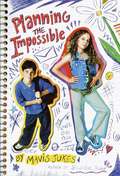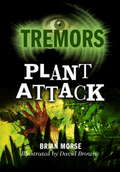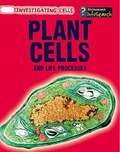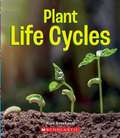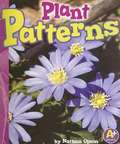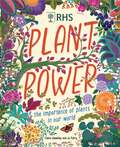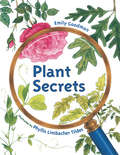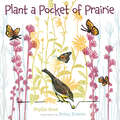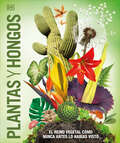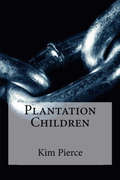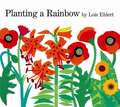- Table View
- List View
Planning the Impossible
by Mavis JukesUgh! Mrs. Furley wanted the Human Interaction Class to discuss a boy's changes? Twelve-year-old River was having a hard enough time just figuring out how to humanly interact with the real people in her life. Like, she was happy that D. B. was her sort-of boyfriend, but now Kirstin was always flirting with him! And River was happy her friend Margaret had found a boyfriend, but then Noah passed River a note asking her to phone him at home. What was that about? Sure River wanted to keep Kirstin from D. B. and Margaret with Noah, but did it all have to be so confusing? Notes passed from girls to boys and boys to girls and girls to girls, dating and mating, flirting and posing--River could never have guessed that talking to a boy would be so difficult.
Plant Attack (Tremors #102)
by Brian MorseThese ghostly adventures and spine-chilling stories are great for reads for reluctant readers. Written by well-known authors and illustrated by much-loved illustrators, this series will appeal to boys and girls.
Plant Attack: Tremors
by David Browne Brian MorseThese ghostly adventures and spine-chilling stories are great for reads for reluctant readers. Written by well-known authors and illustrated by much-loved illustrators, this series will appeal to boys and girls.
Plant Cells And Life Processes
by Barbara A. SomervillThis book explores the features of the plant cell and their life processes.
Plant Life Cycles (A True Book)
by Mara GrunbaumIncredible Plants series introduces young investigative readers to many types of unusual and typical plants from photosynthesis, how they grow, and ways they survive in extreme environments.
Plant Man: The Life and Art of Makoto Azuma (Fountas & Pinnell Classroom, Guided Reading Grade 6)
by Nicole WalkerFrom Guitars to FLOWERS When a young rock musician struggled to pay his bills, he was forced to take a job doing something he never thought he'd do: work in a flower shop. But that fateful turn of events changed Makoto Azuma's life forever. His job soon evolved into a passion for transforming flowers into art. Now, his amazing and outrageous artwork never fails to surprise and delight audiences around the world. NIMAC-sourced textbook
Plant Patterns (Finding Patterns Ser.)
by Nathan OlsonSimple text introduce different kinds of plant patterns.
Plant Power: The Importance of Plants in our World
by Claire LlewellynPlants are amazing! They are found in every part of the world, growing from tiny seeds into beautiful blooms, gigantic trees and the delicious fruit and vegetables we eat. Plants are vitally important to humans, animals and even the climate, providing food, shelter, medicines and even helping to clean our planet's air and water. This book tells you everything you need to know about plants, from how they grow, reproduce and make their own food to the variety of ways that humans and animals use plants every single day.Readers can find out about plant parts and plant life cycles, pollination, food chains, photosynthesis, seeds and plant uses, such as in food, homes, furniture, musical instruments and medicines. We find out how plants can inspire us and how we need to protect plants so they can help protect us.This book is perfect for children aged 7+.
Plant Secrets
by Emily Goodman Phyllis Limbacher TildesPlants come in all shapes and sizes, but they go through the same stages as they grow. Using four common plants, young readers learn about a plant's life cycles.
Plant Secrets
by Emily GoodmanYoung scientists will love this nature mystery that reveals the secrets hiding in seeds, plants, flowers, and fruits throughout the life cycle of various flora. Curiosity will bloom in this introduction to botany and primary nature science. Plants come in all shapes and sizes, but they go through the same stages as they grow. Using four common plants, young readers learn about plant structure and life cycle. Simple text and colorful, detailed illustrations show the major phases of plant growth with each stage holding a &“secret&” for curious readers to guess. Back matter offers more information on each plant, as well as greater detail on each stage of growth.
Plant Signals: How and Why Plants Communicate (Fountas & Pinnell Classroom, Guided Reading Grade 6)
by Corey FlanniganMysterious Communications When hiking in a forest, we admire a redwood's beauty or a pine tree's fragrance. But what we don't notice are the trees' hidden talents. Trees and other plants can actually communicate with one another in surprising ways—and for fascinating reasons. NIMAC-sourced textbook
Plant a Kiss
by Amy Krouse RosenthalFrom the beloved New York Times bestselling author of Dear Girl, Amy Krouse Rosenthal, a simple and timeless celebration of the power of love.Little Miss planted a kiss...One small act of love blooms into something bigger and more dazzling than Little Miss could have ever imagined in this epic journey about life, kindness, and giving.Amy Krouse Rosenthal and Peter H. Reynolds team together to share a message of hope and to remind us all of the joys to be gained from being open and unselfish.Plant a Kiss works to spark the imagination of the youngest readers, but it will also resonate with anyone, such as a new graduate, who responds to the power of planting a kiss.
Plant a Pocket of Prairie
by Phyllis RootAuthor Phyllis Root and illustrator Betsy Bowen last explored the vast, boggy peatlands of northern Minnesota in their book Big Belching Bog. Now, in Plant a Pocket of Prairie, Root and Bowen take young readers on a trip to another of Minnesota&’s important ecosystems: the prairie. Once covering almost 40 percent of the United States, native prairie is today one of the most endangered ecosystems in the world. Plant a Pocket of Prairie teaches children how changes in one part of the system affect every other part: when prairie plants are destroyed, the animals who eat those plants and live on or around them are harmed as well. Root shows what happens when we work to restore the prairies, encouraging readers to &“plant a pocket of prairie&” in their own backyards. By growing native prairie plants, children can help re-create food and habitat for the many birds, butterflies, and other animals that depend on them. &“Plant cup plants,&” Root suggests. &“A thirsty chickadee might come to drink from a tiny leaf pool. Plant goldenrod. A Great Plains toad might flick its tongue at goldenrod soldier beetles.&” An easy explanation of the history of the prairie, its endangered status, and how to go about growing prairie plants follows, as well as brief descriptions of all the plants and animals mentioned in the story. With Betsy Bowen&’s beautiful, airy illustrations capturing the feel of an open prairie and all its inhabitants, readers of all ages will be inspired to start planting seeds and watching for the many fascinating animals their plants attract. What a marvelous transformation could take place if we all planted a pocket of prairie!
Plant and Animal Structures
by Linda CernakAnimal Structures, Plant Structures, Science and Engineering Practices, Careers.
Plant, Cook, Eat!: A Children's Cookbook
by Caroline Craig Joe ArcherFor beginners and green-thumbed foodies, this unusually all-inclusive garden-to-kitchen cookbook is part lesson in gardening and part collection of healthy, delicious, kid-friendly recipes.With vibrant photo-illustrations and clearly organized sections, discover how to plant seeds in patio containers, window boxes, or on an allotment; harvest fruits and vegetables; determine which plant parts are edible; spot pests in the garden; and use home-grown crops to cook everything from bean and bacon spaghetti to polenta chips to tomato, feta, and basil pizza."This effort offers budding young gardeners (and their adults) a comprehensive, hands-on guide to gardening and cooking" — Kirkus Reviews STARRED REVIEW
Plantar semillas: Celebrar la primavera (¡Arriba la Lectura!, Big Book Unit 1 #8)
by Kathryn ClayNIMAC-sourced textbook
Plantas carnívoras: Plantas que comen insectos (¡Arriba la Lectura!, Level O #14)
by Katie SharpNIMAC-sourced textbook
Plantas y hongos (Knowledge Encyclopedia Plants and Fungi!)
by DKExplora el maravilloso mundo de las plantas y los hongos, desde los cactus y las plantas carnívoras hasta los árboles, las flores y los hongos.¿Por qué las flores son coloridas y las frutas son dulces? ¿Cómo captura una planta carnívora a su presa? ¿Por qué pican las ortigas? ¿Cómo convierten los árboles la luz en alimento? Este libro sobre la naturaleza para niños fascinará a los lectores más jóvenes con detalles microscópicos y datos curiosos sobre el reino de las plantas y los hongos.En su interior, encontrarás: Datos, gráficos, líneas temporales e ilustraciones de una amplia gama de temas.Un enfoque visual único de las plantas y los hongos de todo el mundo, gracias a sus impresionantes y detalladas imágenes en 3D.Información valiosa que sirve de apoyo para los estudiantes de ciencias.¡La vida en la Tierra no podría existir sin plantas y hongos! Crean los alimentos que comemos y el oxígeno que respiramos, regulan el clima, proporcionan hábitats para los animales y producen recursos sostenibles que podemos usar para hacer libros, ropa, muebles y casas. Plantas y hongos muestra cómo estos seres vivos son los cimientos de todos los ecosistemas y hacen de nuestro planeta un lugar habitable. ¿A qué esperas para aprenderlo todo sobre los organismos imprescindibles para la vida en la Tierra?Explore the wonderful world of plants and fungi, with everything from cacti and carnivorous plants to trees, flowers, and mushrooms.Why are flowers colorful and fruits sweet? How does a carnivorous plant kill its prey? Why do stinging nettles sting? How do trees turn light into food? This ultimate nature book for children will fascinate young readers with its microscopic detail and amazing facts on the plant world. This all-encompassing nature encyclopedia for kids offers: A whole collection of facts, charts, timelines, and illustrations that cover a vast range of topics.Plants and fungi from around the world shown using amazingly detailed CGIs that entice young readers to dive in and explore.Important STEM topics covered in life sciences curricula.A visual approach using illustrations, photographs and extremely detailed 3D CGI images.Knowledge Encyclopedia: Plants and Fungi! shows how plants and fungi form the foundations of every ecosystem, making our planet habitable. Life on Earth couldn’t exist without plants and fungi. Plants create the food we eat and the oxygen we breathe. They regulate the climate, provide habitats for animals, and produce sustainable resources that we can use to make books, clothes, furniture and houses. Fungi are just as important.
Plantation Children
by Kim PierceTennessee, 1862. Fifteen-year-old Elizabeth Edwards hates her personal slave, Anna. Elizabeth has never given much thought to the plight of the slaves on her father's plantation; instead, she focuses on pretty dresses and horses, and dreams of the young man she wants to marry.But Elizabeth's world collapses when she is told she must marry her cousin to keep the plantation in the family. Elizabeth takes out her anger on Anna, who finally snaps and reveals that Elizabeth and she have the same father. Anna is brutally whipped the next day, and Elizabeth is horrified. When she tries to confide in her mother, she finds her secretly kissing Elizabeth's tutor.Elizabeth now feels she has nothing and nobody. She changes her attitude about Anna and asks her to run away with her. They are overheard by two stable hands, Fred and Sam, who have heard of a safe house on the Underground Railroad. The four of them set off, planning to reach Canada.Will they all make it to Canada alive? Does Anna truly forgive Elizabeth, or is she just using her? Is it possible to find love on the run?
Planted with Love: Growing into a Family
by Natasha TripplettA heartfelt picture book about one child's experience in foster care that reminds all kids that—just like a garden—love from the right source will help them bloom.Lamar has lived in seven homes in three years and has never stayed anywhere long enough to put down roots. As he watches his new foster mom tend to her garden each day, he soon joins her with cautious curiosity. Together, they plant, they weed, they water . . . until one day Lamar's anger and feelings of uncertainty lead him to destroy the garden.But through his foster mother's love and care, Lamar discovers that just like her garden, he is wanted, he is loved, he has been planted, and he will bloom.Written by a licensed social worker, Planted with Love illustrates that a loving home and a loving adult can provide a safe place for any child to grow and thrive.
Planting A Rainbow
by Lois EhlertThis educational and enjoyable book helps children understand how to plant bulbs, seeds, and seedlings, and nurture their growth. Lois Ehlert's bold collage illustrations include six pages of staggered width, presenting all the flowers of each color of the rainbow.
